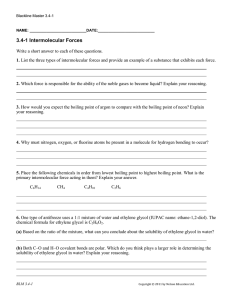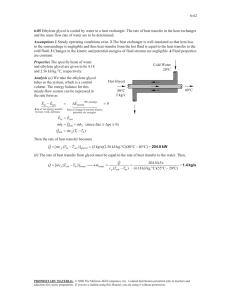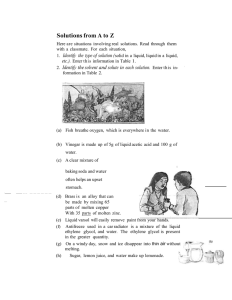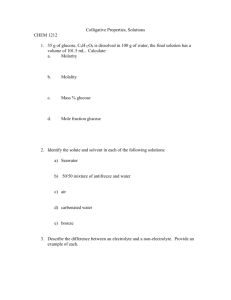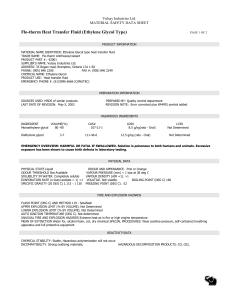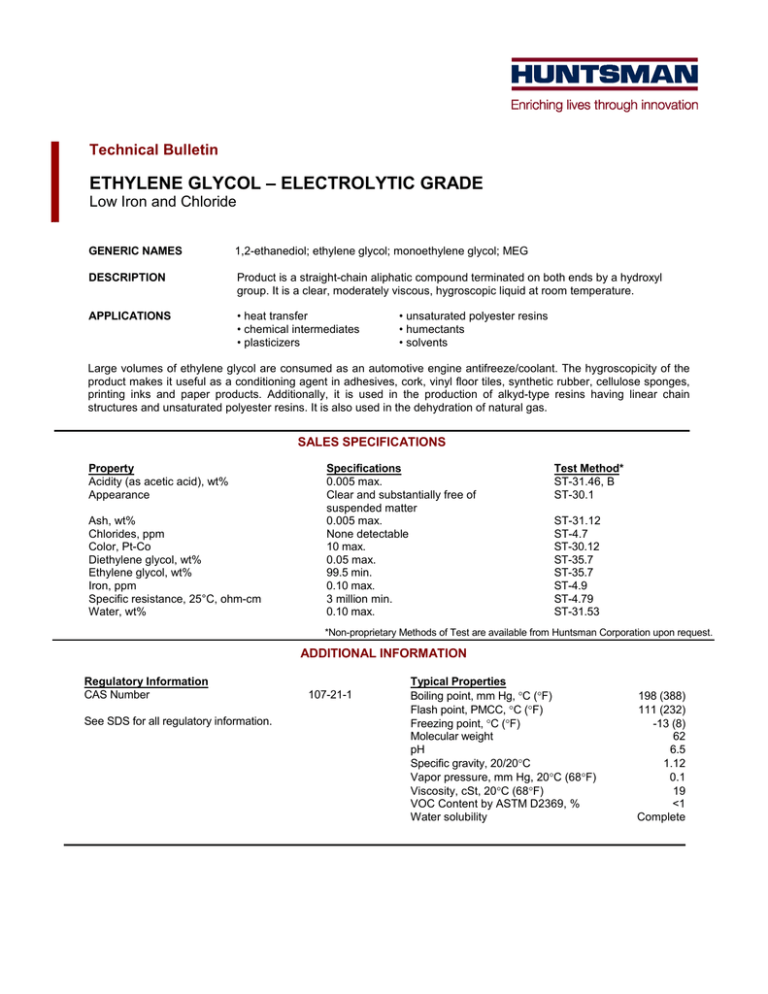
Technical Bulletin
ETHYLENE GLYCOL – ELECTROLYTIC GRADE
Low Iron and Chloride
GENERIC NAMES
1,2-ethanediol; ethylene glycol; monoethylene glycol; MEG
DESCRIPTION
Product is a straight-chain aliphatic compound terminated on both ends by a hydroxyl
group. It is a clear, moderately viscous, hygroscopic liquid at room temperature.
APPLICATIONS
• heat transfer
• chemical intermediates
• plasticizers
• unsaturated polyester resins
• humectants
• solvents
Large volumes of ethylene glycol are consumed as an automotive engine antifreeze/coolant. The hygroscopicity of the
product makes it useful as a conditioning agent in adhesives, cork, vinyl floor tiles, synthetic rubber, cellulose sponges,
printing inks and paper products. Additionally, it is used in the production of alkyd-type resins having linear chain
structures and unsaturated polyester resins. It is also used in the dehydration of natural gas.
SALES SPECIFICATIONS
Property
Acidity (as acetic acid), wt%
Appearance
Ash, wt%
Chlorides, ppm
Color, Pt-Co
Diethylene glycol, wt%
Ethylene glycol, wt%
Iron, ppm
Specific resistance, 25°C, ohm-cm
Water, wt%
Specifications
0.005 max.
Clear and substantially free of
suspended matter
0.005 max.
None detectable
10 max.
0.05 max.
99.5 min.
0.10 max.
3 million min.
0.10 max.
Test Method*
ST-31.46, B
ST-30.1
ST-31.12
ST-4.7
ST-30.12
ST-35.7
ST-35.7
ST-4.9
ST-4.79
ST-31.53
*Non-proprietary Methods of Test are available from Huntsman Corporation upon request.
ADDITIONAL INFORMATION
Regulatory Information
CAS Number
See SDS for all regulatory information.
107-21-1
Typical Properties
Boiling point, mm Hg, °C (°F)
Flash point, PMCC, °C (°F)
Freezing point, °C (°F)
Molecular weight
pH
Specific gravity, 20/20°C
Vapor pressure, mm Hg, 20°C (68°F)
Viscosity, cSt, 20°C (68°F)
VOC Content by ASTM D2369, %
Water solubility
198 (388)
111 (232)
-13 (8)
62
6.5
1.12
0.1
19
<1
Complete
PRODUCT SAFETY POLICY
It is the product safety policy of Huntsman Corporation to provide our customers with information on the safe handling
and use of our products. The Safety Data Sheet (SDS) should always be read and understood thoroughly before
handling the product and adequate safety procedures should be followed. Information on the toxicity, environmental and
industrial hygiene aspects of our products may be found in the SDS. Precautionary measures include: use only with
adequate ventilation; avoid breathing vapor, mist or gas; avoid contact with eyes, skin and clothing; keep container
closed; wash thoroughly after handling.
HANDLING AND STORAGE
Ethylene glycol is a stable, non-corrosive chemical with high flash point. Since it is hygroscopic, storage vessels must be
designed to minimize moisture pickup. Other possible contaminants are iron and oxygen. For longer term storage, or
where iron contamination and color are objectionable, resin linings or stainless steel and aluminum vessels are
recommended. Linings based on phenolic and epoxy resins are satisfactory. Zinc or zinc alloys should not be used in
glycol service. For longer term color stability, it is recommended that the product be stored under an inert atmosphere.
Cast-iron or centrifugal pumps with stainless shafts and impellers are satisfactory. Rubber-lined or rubber-bound gaskets
should be avoided. Flexible graphite filled or stainless steel double jacketed gaskets are usually effective larger gaskets.
Stainless steel winding with flexible graphite filler piping gaskets performs well. Pipe thread lubricants based on
corrosion inhibiting zinc compounds or a graphite based lubricant with aluminum are generally satisfactory; however,
glycols are excellent penetrants and leaks may be present where hydrostatic testing has indicated a tight system.
Therefore, the system should be rechecked after the glycol has been added.
Low pressure stainless steel steam coils in storage tanks and steam tracing of transfer lines may need to be provided in
cases where low environmental temperatures may make pumping of the product difficult. Transfer or storage tanks can
be readily cleaned by flushing with water and steam.
AVAILABILITY
Product is available in tank cars, tank trucks and non-returnable drums (510 pounds net). Containers are stainless steel,
aluminium or suitably lined. Certain government regulations may apply at the time of shipment.
5033-0316
Huntsman Corporation
Business Offices
10003 Woodloch Forest Dr.
The Woodlands, TX 77380
(281) 719-6000
Huntsman Advanced Technology
Center
Technical Service
8600 Gosling Rd.
The Woodlands, TX 77381
(281) 719-7780
Samples 1-800-662-0924
www.huntsman.com
Copyright © 2007, 2010, 2016 Huntsman Corporation or an affiliate thereof. All rights reserved.
Huntsman Corporation warrants only that its products meet the specifications stated in the sales contract. Typical properties, where stated, are to
be considered as representative of current production and should not be treated as specifications. While all the information presented in this
document is believed to be reliable and to represent the best available data on these products, HUNTSMAN MAKES NO WARRANTY OR
GUARANTEE OF ANY KIND, EXPRESS OR IMPLIED, INCLUDING BUT NOT LIMITED TO ANY WARRANTY OF MERCHANTABILITY OR
FITNESS FOR A PARTICULAR PURPOSE, NON-INFRINGEMENT OF ANY INTELLECTUAL PROPERTY RIGHT OF ANY THIRD PARTY, OR
WARRANTIES AS TO QUALITY OR CORRESPONDENCE WITH PRIOR DESCRIPTION OR SAMPLE, AND ANY USER OF PRODUCTS
DESCRIBED HEREIN SHOULD CONDUCT A SUFFICIENT INVESTIGATION TO ESTABLISH THE SUITABILITY OF ANY PRODUCT FOR ITS
INTENDED USE AND ASSUMES ALL RISK AND LIABILITY WHATSOEVER RESULTING FROM THE USE OF SUCH PRODUCT, WHETHER
USED SINGLY OR IN COMBINATION WITH OTHER SUBSTANCES. Products may be toxic and require special precautions in handling. For all
products described herein, the user should obtain detailed information on toxicity, together with proper shipping, handling, and storage
procedures, and should comply with all applicable safety and environmental standards. The behavior, hazards and/or toxicity of the products
referred to in this publication in manufacturing processes and their suitability in any given end-use environment are dependent upon various
conditions such as chemical compatibility, temperature, and other variables, which may not be known to Huntsman. It is the sole responsibility of
the user of such products to evaluate the manufacturing circumstances and the final products under actual end-use requirements and to
adequately advise and warn future purchasers and users thereof.


